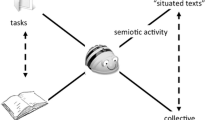Abstract
A previous study shows how a twelve-year-old girl discovers angles in her narrative from a climbing trip. Based on this research, the girl’s class takes part in one day of climbing and half a day of follow-up work at school. The students mathematise their climbing with respect to angles and they express themselves in texts and drawings. Their written and drawn expressions are categorised into three different levels: recognition, description and contextual tool. In addition, these expressions are interpreted to be narrative or analytical. All the narrative expressions were categorised as level one or below, while some of the analytical expressions were categorised as belonging to higher levels. The research findings point at how to use analytical drawings in work with analytical texts in geometry.



Similar content being viewed by others
Notes
Three students who all succeeded well in the pre-test and who enjoy climbing as well were absent the first day and could not be part of the project. Two more students did not take part in the CCP as their parents did not sign the written permission. However, these two students joined their class both of the days.
References
Berthelot, R., & Salin, M. H. (1998). The role of pupil’s spatial knowledge in the elementary teaching of geometry. In C. Mammana & V. Villani (Eds.), Perspectives on the teaching of geometry for the 21st century (pp. 71–78). Dordrecht: Kluwer.
Berthoz, A. (2000). The brain’s sense of movement. Cambridge, MA: Harvard University Press.
Clements, D. H. (2003). Teaching and learning geometry. In J. Kilpatrick, W. G. Martin & D. Schifter (Eds.), A research companion to principles and standards for school mathematics (pp. 151–178). Reston, VA: National Council of Teachers of Mathematics.
Collins (2000). English dictionary and thesaurus. Aylesbury: HarperCollins.
Csikszentmihalyi, M. (2000). Beyond boredom and anxiety. Experiencing flow in work and play. San Francisco: Jossey-Bass (Original work published in 1975).
Freudenthal, H. (1973). Mathematics as an educational task. Dordrecht: Reidel.
Freudenthal, H. (1983). Didactical phenomenology of mathematical structures. Dordrecht: Reidel.
Freudenthal, H. (1991). Revisiting mathematics education: China lectures. Dordrecht: Kluwer.
Fyhn, A. (2004). How can experiences from physical activities in the snow influence geometry learning? Paper at ICME 10 (10th International Congress of Mathematics Education, Copenhagen, 4th–11th July), Topic Study Group 10 Geometry http://www.icme-organisers.dk/tsg10/articulos/Fyhn_4_revised_paper.doc.
Fyhn, A. (2006). A climbing girl’s reflection about angles. Journal of Mathematical Behavior, 25, 91–102.
Gjone, G., & Nortvedt, G. (2001). Kartlegging av matematikkforståelse. Veiledning til geometri F og I. Oslo: Directorate for Primary and Secondary Education.
Gravemeijer, K., & Doorman, M. (1999). Context problems in realistic mathematics education: A calculus course as an example. Educational Studies in Mathematics, 39, 111–129.
Grønmo, L. S., Bergem, O. K., Kjærnsli, M., Lie, S., & Turmo, A. (2004). ’Hva i all verden har skjedd i realfagene? Norske elevers prestasjoner i matematikk og naturfag i TIMSS 2003’: Acta Didactica 5, Vol 5. ILS: University of Oslo.
Henderson, D. W., & Taimina, D. (2005). Experiencing geometry. Euclidean and non-Euclidean with history. New York: Cornell University.
Johnsen, V. (1996). Hva er en vinkel? NOMAD Nordisk Matematikkdidaktikk/Nordic Studies in Mathematics Education, 4, 25–49.
Kjærnsli, M., Lie, S., Olsen, R. V., Roe, A., & Turmo, A. (2004). Rett spor eller ville veier? Norske elevers prestasjoner i matematikk, naturfag og lesing i PISA 2003. Oslo: Universitetsforlaget.
Krainer, K. (1991). Consequences of a low level of acting and reflecting in geometry learning – findings of interviews on the concept of angle. Proceedings of the 15th International Conference, Psychology of Mathematics Education, Vol. 2 (254–261). Assisi, Italy.
Krainer, K. (1993). Powerful tasks: A contribution to a high level of acting and reflecting in mathematics instruction. Educational Studies in Mathematics, 24, 65–93.
KUF, Ministry of Education and Research (1996). Læreplanverket for den 10-årige grunnskolen. Oslo: Nasjonalt Læremiddelsenter.
Lakoff, G., & Núñez, R. (2000). Where mathematics comes from. How the embodied mind brings mathematics into being. New York: Basic Books.
Mitchelmore, M. C., & White, P. (2000). Development of angle concepts by progressive abstraction and generalisation. Educational Studies in Mathematics, 41, 209–238.
Murphy, P., & Elwood, J. (1998). Gendered learning outside and inside school: influences on achievement. In D. Epstein, J. Elwood, V. Hey, & J. Maw (Eds.), Failing boys?: Issues in gender and achievement (pp. 162–181). Buckingham: Open University Press.
Nemirovsky, R., Borba, M., & Dimattia, C. (2004). PME special issue: Bodily activity and imagination in mathematics learning. Educational Studies in Mathematics, 57, 303–321.
Niss, M. (1999). Aspects of the nature and the state of research in mathematics education. Educational Studies in Mathematics, 40, 1–24.
Treffers, A. (1987). Three dimensions. A model of goal and theory description in mathematics instruction – The Wiskobas Project. Dordrecht: Reidel.
van den Heuvel-Panhuizen, M. (2003). The didactical use of models in realistic mathematics education: An example from a longitudinal trajectory on percentage. Educational Studies in Mathematics, 54, 9–35.
van Hiele, P. M. (1986). Structure and insight. A theory of mathematics education. Orlando: Academic.
Watson, A., & Tall, D. (2002). Embodied action, effect and symbol in mathematical growth. In A. Cockburn & E. Nardi (Eds.), Proceedings of the 26th Conference of the International Group for the Psychology of Mathematics Education Norwich, UK, 369–376.
Acknowledgements
Thanks a lot to teacher Frode Hansen and his class for their contribution to this work. I also would like to thank Odd Valdermo both for his support and for all his critical advice. Thanks to Therese Nøst who has contributed with advice and comments regarding climbing. Thanks to Tore Brattli for his excellent library support, Linn Sollied Madsen for language checking and Bjørn Braathen for advice as for the structure of the manuscript. Finally I would like to thank Hanne, Inger Johanne and Trine for belaying the climbing students.
Author information
Authors and Affiliations
Corresponding author
Electronic supplementary material
Below is the link to the electronic supplementary material.
(WMV 67 MB)
Rights and permissions
About this article
Cite this article
Fyhn, A.B. A climbing class’ reinvention of angles. Educ Stud Math 67, 19–35 (2008). https://doi.org/10.1007/s10649-007-9087-z
Received:
Accepted:
Published:
Issue Date:
DOI: https://doi.org/10.1007/s10649-007-9087-z




